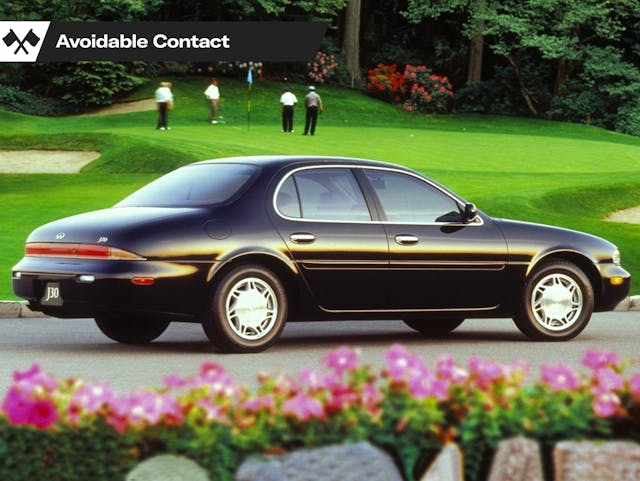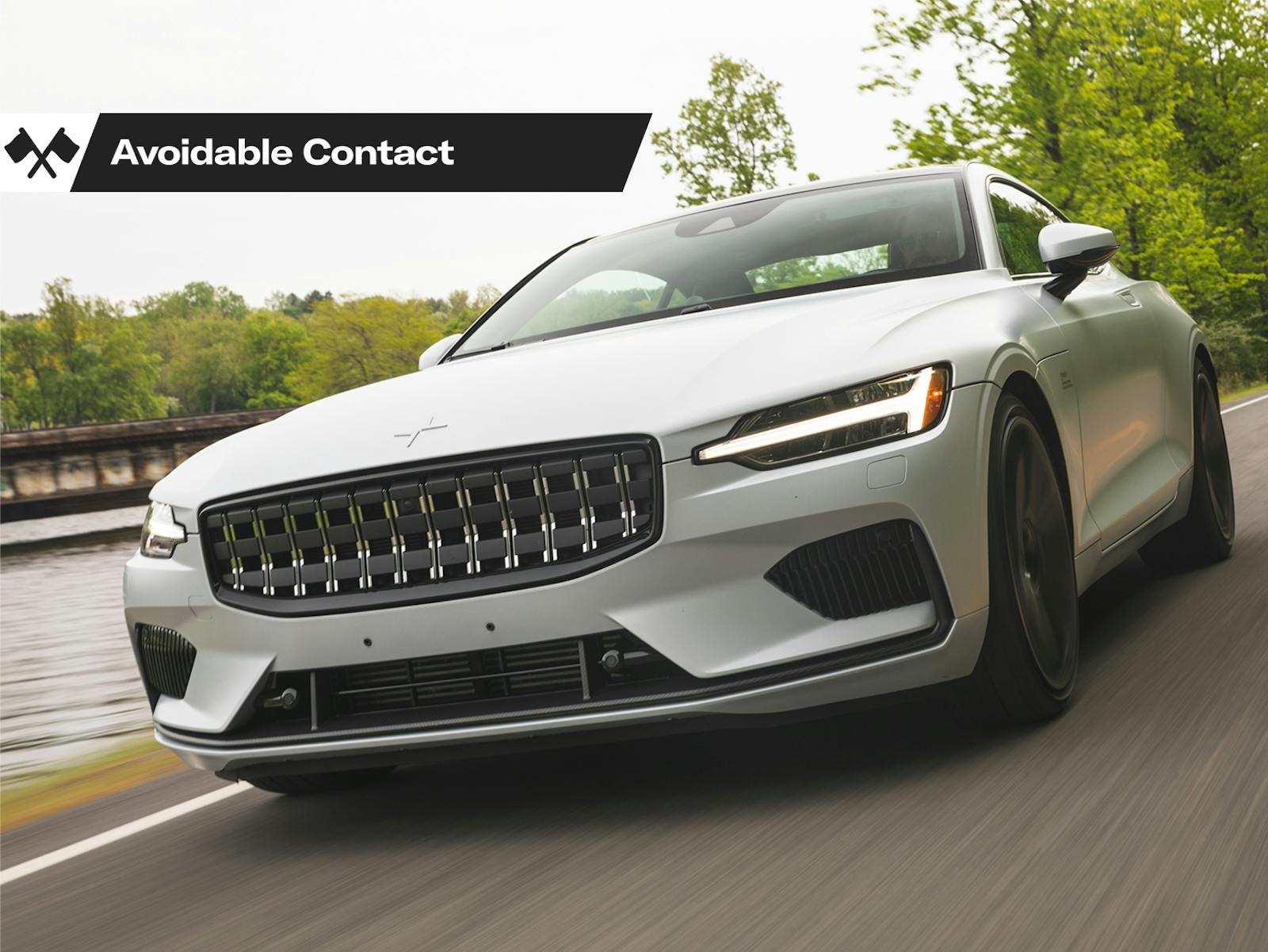Avoidable Contact #117: In which a student body vice president tells tales of a Japanese Jaguar

Live in reality. That’s the closest thing I have to a personal motto. Sounds simple, and it is, but it’s frequently miserable. Baseless optimism is how most of us get through life—that, and a habit of telling ourselves comforting lies about our capabilities, our success, how much we are loved by others, and so on. Let that go and the world can look awfully bleak, awfully Prufrock-esque, if you will. Yet there’s power in it.
Here’s an example: In eighth grade, the prettiest girl in my Catholic school asked me to be her running mate in the election for student body president. It would be a tough campaign, because our opponents would be the two most popular fellows in our class. I accepted immediately because I would have accepted any proposition Annamaria put forth to me, regardless of its merits or the personal misery involved. This was a dream come true and could possibly even lead to us dating. (Just so the reader understands the hilarity of this, I was 11 years old in eighth grade, uglier than a frog’s hind end, and 4-foot-11 besides. Annamaria was 14 and world-class gorgeous, a status she has retained to the present day.)
After school, I went over to my friend Ron’s house to play “Star Raiders” on his Atari 800, and that’s when I found out that I wasn’t Annamaria’s first choice. More like her sixth or seventh. Nobody wanted to run against our friends Tom and Sean. I ran home and seriously considered crying about it. What a humiliation! Couldn’t sleep that night. But the next morning I resolved to live in reality. I told Annamaria I knew she’d asked everyone else, but I didn’t care. I also knew that we couldn’t win the eighth-grade vote—but this was an all-school vote. So while Tom and Sean strutted around and talked about how they were going to get a Coke machine in the gym (a perennial dream of St. Agatha student body presidents that would not come to pass until a decade later), I relentlessly campaigned to the kids in grades one through seven. Talked to every single one of them. Said that Annamaria understood what it was like to be a scrawny, unhappy kid at the school. After all, wasn’t that why she had picked me to run with her? Why, this incandescent princess, the daughter of millionaires, was just like us!
We won the election in a landslide. Wasn’t even close. Best of all, and by best of all I mean worst of all, was that Annamaria and Sean started dating almost immediately after the election, leading her to forget all about being student body president and allowing me to basically become the Lyndon B. Johnson of our school, albeit a completely powerless LBJ whose every idea was immediately rejected by a 62-year-old nun.
Anyway. Twelve years after that election, I found myself working at an Infiniti dealership, tasked with selling the nearly-new J30 sedan to the yuppies of Columbus, Ohio. The J30, in case you’ve forgotten, was Jerry Hirshberg’s attempt to “break the tyranny of the wedge.” While the astounding 1992 Toyota Camry is often cited as the peak of Japan’s ability to completely over-build and over-deliver on a relatively prosaic automobile, the 1993 J30 was perhaps an even more outrageous example of the era.
For the modest sum of $33,000, basically the price of a BMW 325i with a few options, you got what was more or less a four-door 300ZX, built in Tochigi with fanatic precision and seemingly no expense spared whatsoever. The body panels were intricate and fitted with millimeter precision, the interior shamed anything coming from Mercedes-Benz or Lexus at the time. It was quiet on the road and felt like it had been machined from a single billet. Every switch in the car was heavily damped. There were no options; you simply chose between the plain J30 and the J30t with four-wheel steering. Even the advertising was a remarkable recovery from the early “rocks and trees” catastrophe that had done so much to sink Nissan’s new luxury brand in the states:
Even if you didn’t like the looks—and many people didn’t—it was hard to deny that the J30 was basically a Japanese Jaguar, a moonshot effort of styling and execution that was to the XJ6 of the time what the LS400 was to a Benz 300E. My father took one look at the thing, tossed his Audi 100 to the curb, and bought two of them; a triple-black car for him and a blue-over-cream for his wife. The color on the latter one was a mile deep and didn’t have anything remotely resembling orange peel. If you want paint like that now you have to buy a Rolls-Royce.
Lovely cars, and I loved selling them. But let’s live in reality here: the fact is that most people only took delivery of a J30 because NMAC, the long-suffering Nissan finance company, was kicking them out the door on $399/month leases, with $2500 down. Here’s the killer part: the dealership had about $4K markup in the car at that price, so we could (and did) let them roll at $399/month with nothing down, if that’s what the customer demanded. It was a three-year lease, fully in warranty if you stuck to the 36K mileage limit.
This was an awfully bold program at the time. The equivalent Lexus, the GS300, was a $600/month lease, easy. The Germans were even worse; the three-year payments on them were basically the same as five-year finance payments, so $800/month for a 525i. We had a car that rode better, had a nicer sound system, and absolutely coddled its occupants … available for half price.
Yet even at half price the J30 was a tough sell. A lot of people thought it looked like an Altima, and they weren’t exactly wrong, even if they weren’t exactly right. I hated hearing the Altima comparison. Five minutes with the two cars would disabuse you of any notion that the mirror-smooth, rear-drive, fully-equipped J30 was anything like the truck-four-banger-equipped, rattle-and-hum economy-car Altima, but nobody wanted to take that time. My suggestion to my dealer principal that we buy an Altima and park it next to the J30 on the showroom floor, all the better to show the contrast between the two, was cheerfully ignored.
Nowadays, we’d call the J30 a “four-door coupe,” and indeed the morons who edit Wikipedia have gone back and claimed something to that effect, but at the time it was just called “really cramped.” Up front, you had a 300ZX’s worth of room. In back … you had a 300ZX’s worth of room. A lazy four-speed automatic transmission was the only option at a time when a lot of sporting fellows still took a stick shift in their mid-sized luxury sedan. Combined with a relatively sleepy three-liter V-6, the result was modest performance at best. The “Super HICAS” rear-steering of the J30t, while thoroughly amusing to your humble author at the time, could be frightening to people coming from Lincoln Town Cars and whatnot; we had a couple of those cars come back to us with a few hundred miles on the clock and the demand to “make it disappear, no matter what it costs.” Also, the J30t rear spoiler was frankly ridiculous-looking and spoiled the look of the car.
That $399/month deal, heavily advertised on TV and in our local paper, had the unintended consequence of killing any traditional purchase interest people had in the J30. “Why would I buy this car,” one Boomer client asked me, “when everybody will think I got it for the price of a Honda?” We sold most of our G20 and Q45 inventory on five-year finance, with the occasional “cash” deal funded by home equity, but the J30 was effectively a lease-only proposition, and we went months without actually selling one in conventional fashion.
In 1995, Nissan put stupid-looking ribbed taillights on the thing and, to my horror, raised the price for the third consecutive year. The base car had arrived at $33K but it was now $39K. When the lease deal disappeared, the cars became showroom paperweights. Traffic in our Infiniti showroom was already fearsomely light; I would occasionally go a whole Monday through Friday without getting an “up” on the lot. When the leases disappeared, so did the remaining customers. The dealer principal hired a “shit-kicker” general manager who had come up through the ranks in a Hyundai dealership. Looking back, he was a good man who understood a lot about selling cars, and if I’d stuck around I could have learned something from him, but at the time I couldn’t abide his polyester suits, his jet-engine voice, and his breath. After 30 days of unhappy coexistence I hit the bricks. It was the last time I’d work for a “luxury” brand.
As the ’90s dragged on, the J30 went out with a whimper of rapidly declining sales and obvious de-contenting. Its eventual kind-of replacement, the G35, revitalized the Infiniti brand, turned the lights back on in the showrooms, and helped disguise the fact that the company had been struggling along until then by selling a Pathfinder with a body-color nose known as the QX4.
The lack of manual transmission and genuine performance intent, coupled with the cramped interior and high servicing costs, meant that most J30s never found an enthusiast home and instead went to the junkyard long before their German counterparts. (Somewhat ironically, the same don’t-care fate befell the Lexus GS of the time; when was the last time you saw one?) I’ve seen a couple of teams racing the J30 in cheap-car enduros; if you can live with the shrink-wrapped engine compartment and dim-witted gearbox, it’s not a bad way to get around a track. In 2021, however, you’re more likely to see a 1994 Skyline on the American road than you are to see a 1994 J30.
If we live in reality, we have to accept that the rounded-off Infiniti was a failure. Blaise Pascal, in his Pensees, wrote:
The spirit of grace; the hardness of the heart; external circumstances.
I think the J30 had the spirit of grace. It was beautiful in its own way and was executed with intense care. But the customers’ hearts were hard and it fell victim to circumstances beyond its control—everything from the fact that the 5-series segment has always been a dead zone for Japanese luxury brands to the stupidity of trying to build an upscale presence by blaring “$399/MONTH!” on television. That’s reality. Not that hard to accept, really.
This is what I find harder to accept: We no longer live in a world where an automaker would be willing to take a chance on something like the Infiniti J30. There are no more oddball passion projects, no more moonshot exercises of design or enthusiasm. We lost that when the manufacturers decided to burn billions upon billions of dollars on the altar of electric vehicles and compliance cars. All the cream at the top has been skimmed and given to battery-powered trash. Everything else has to earn its keep. Crossovers for the proles, trucks for the blue-collar wealthy, supercars for the rich. That’s it. That’s the business now. And it’s reality. But I sure wouldn’t mind seeing a change.
What can I do about it? Hard to say. I could get a bunch of activist shareholders to install me at the head of an automaker. I’d ditch the EVs, ditch the government pandering, and build great cars for the people who actually want them. Heck of a platform. It’s possible that I’m a little too controversial, too unpleasant, too toxic to hold the top seat at General Motors or BMW. But I am willing to serve at the right hand of someone who is more palatable. It should be a woman, because this is very much the age of female leadership. I know just the person. She’s smart, hard-working, successful. I haven’t seen her since I was 11, but I haven’t changed much since then, and maybe she’s the same as well.
(No, I don’t always live in reality, despite my best efforts.)

